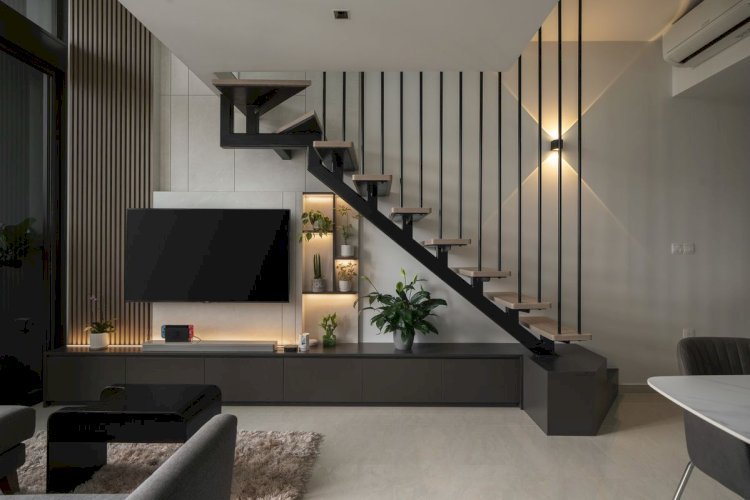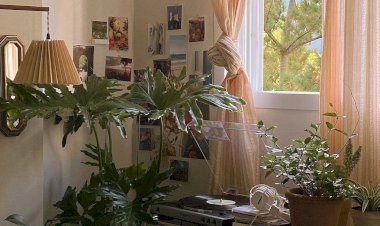Living Room Staircase Ideas: Modern, Stylish & Space-Saving Designs
Explore stunning staircase ideas for your living room — from floating and minimalist designs to rustic wood styles that enhance space, light, and beauty.

A staircase in the living room can do more than connect floors — it can define the style and mood of your home. The best living room stairs ideas focus on combining beauty with practicality. Floating or open-riser staircases make small spaces look larger and brighter, while wooden stairs with glass or metal railings add a modern, elegant touch. Using the space under the stairs for storage or a reading corner can help you make the most of every inch. Good lighting, safe handrails, and matching materials are key to creating a staircase that feels seamless within your living room design.
A staircase inside the living room can completely change the way a home feels. It links floors, but it also connects styles, materials and moods. In modern homes, the staircase is no longer a background feature; it can be the centrepiece that adds openness, structure and character. With thoughtful planning, it can make a small room appear larger, define zones in an open plan and add sculptural interest without overwhelming the space.
This guide gathers practical and creative ideas on how to design a staircase that enhances both space and beauty. The focus is on clear explanations, simple language and ideas that work for real homes.
The Role of the Staircase in Modern Interiors

Image source: Pinterest.com
In older houses, stairs were often enclosed or hidden away, mainly built for function. Contemporary design has turned them into architectural statements. When a staircase begins in the living room, it immediately becomes part of the décor, influencing the atmosphere and the way light and movement flow through the area. The materials, railing style and direction all matter. A solid concrete stair can feel grounded and permanent; a glass and metal one feels light and modern. The challenge is to find a design that fits your home’s personality and practical needs.
Modern Minimalist Staircases

Image source: Pinterest.com
The modern minimalist approach remains one of the most popular. These staircases combine clean lines with honest materials such as wood, metal and glass. A typical example uses slim oak treads, a black steel frame and clear glass balustrades. The combination creates visual transparency and allows natural light to travel through the room, making it appear more spacious. In homes with large windows, the reflective quality of glass and metal spreads light beautifully.
To prevent the space from feeling cold, pair these materials with warm wall tones or textured fabrics on nearby furniture. Minimalist stairs work best when the surrounding décor is equally restrained: plain walls, concealed storage and neutral colours keep the focus on form rather than ornament.
Floating and Cantilevered Designs

Image source: Pinterest.com
Floating stairs are among the most striking ways to create openness. Each step seems to project directly from the wall, giving the impression that it hovers in the air. Structurally, the support is hidden within the wall or anchored by a steel spine, but to the eye the staircase looks weightless. This design is ideal for smaller living rooms because it occupies very little visual space.
Lighting plays a key role. A narrow LED strip fitted under each tread adds a soft glow that outlines the stair at night. Because floating stairs expose both sides, they look best against a simple backdrop—plain plaster, timber cladding or polished concrete. Always confirm that the structure is engineered correctly and that the treads have an anti-slip finish.
The Hidden Stairwell

Image source: Pinterest.com
At the opposite end of the spectrum is the concealed staircase. Here, part of the stair is tucked behind a wall or integrated into cabinetry so that it almost disappears. The effect is sleek and modern, perfect for interiors that value clean surfaces. Often the steps start just before the dividing wall, leading visitors naturally upward while maintaining privacy for the rooms beyond.
Illumination is essential; hidden stairs can look gloomy if not lit properly. Recessed ceiling lights or a row of warm wall lamps will make the passage feel inviting. The wall beside the entry can hold a simple shelf, artwork or mirror to mark the transition between spaces.
Spiral and Curved Forms

Image source: Pinterest.com
Spiral staircases have been used for centuries and continue to charm designers because they save floor space and add sculptural drama. A spiral made of black iron with timber treads suits industrial or rustic interiors, while one built from brushed steel and glass fits a contemporary apartment. The trick is proportion: wide enough steps and a gentle curve ensure comfort and safety. In an open living room, placing a spiral stair near a window allows natural light to outline its shape throughout the day.
Curved or helical staircases—wider and smoother than traditional spirals—offer a sense of flow and elegance. They work well in large rooms or duplexes where the stair can stand free as an architectural statement. A simple pendant light hanging through the centre emphasises the graceful movement.
Rustic Warmth and Natural Materials

Image source: Pinterest.com
Not every home needs sharp lines and glass panels. Many people prefer the warmth of wood and the honesty of natural materials. A rustic staircase made from reclaimed timber with visible knots and grains brings comfort and authenticity. When paired with wrought-iron railings, it bridges traditional and modern design. Add a tall plant or a clay pot near the base to introduce greenery and soften the heavy textures.
For a slightly modern twist, combine wood with matte black steel supports or slender vertical balusters. This pairing offers strength and contrast without losing the organic feel.
Under-Stair Possibilities

Image source: Pinterest.com
The area below a staircase often goes unused, yet it can serve many purposes. In smaller living rooms, this zone can become valuable storage or a decorative feature. Built-in drawers or cupboards can hold shoes and household items, keeping the room tidy. Open shelving can form a small library or a display for art and photographs. Some homeowners transform the space into a reading corner with a cushioned bench and a wall lamp. If natural light reaches the spot, a miniature indoor garden or collection of potted plants can enliven it. Thoughtful lighting ensures that this nook feels intentional rather than leftover.
Read Also: Home Decor Design Interior Ideas to Give Your Home a Luxurious Look
Artistic and Patterned Ideas

Image source: Pinterest.com
A staircase can be an artwork in itself. Instead of leaving risers plain, designers now decorate them with patterned tiles, painted stripes or mosaic pieces. Each step becomes a brushstroke in a larger picture. Mediterranean motifs in blue and white, geometric black-and-white designs or subtle stone inlays can all add personality without clutter.
Another way to introduce art is through the railing. Laser-cut metal panels, geometric grids or sculpted wooden slats create rhythm and texture. When you choose such a strong element, keep the surrounding décor simple so that the staircase remains the star.
Playing with Colour and Contrast

Image source: Pinterest.com
Colour dramatically changes perception. Dark stairs against pale walls look bold and modern; light stairs on dark flooring feel airy. Painting the entire staircase black, once rare, is now a recognised trend. It provides ins
ant depth and elegance. For a subtler statement, highlight only the final step or landing with a different material—perhaps marble, granite or stained wood. This small accent adds luxury without large expense.
If your living room is neutral, consider painting the stair wall a deep tone such as charcoal or forest green. The contrast frames the steps and turns them into a focal point.
Lighting as Design

Image source: Pinterest.com
Lighting is one of the most effective ways to transform an ordinary staircase. Recessed step lights provide safe footing and a gentle ambiance. LED strips along the underside of treads create a floating illusion. Wall washers or small spotlights can emphasise texture, especially on stone or wood. In double-height spaces, a pendant or chandelier suspended above the stairway adds drama and draws the eye upward. Smart lighting systems that activate when someone approaches are convenient and energy-efficient. Always select warm colour temperatures for wood and neutral white for glass or metal to maintain harmony with surrounding materials.
Green Touches and Biophilic Design

Image source: Pinterest.com
Integrating nature into stair design is another growing trend. Small planters along the railing, vines cascading down the balustrade or a vertical green wall beside the steps introduce freshness and calm. Artificial plants can achieve a similar effect when natural light is limited. Combining greenery with natural materials such as stone and wood strengthens the connection to nature, an approach known as biophilic design. Even a single tall plant placed at the foot of the stairs can soften the geometry and bring balance.
Classic and Vintage Inspirations

Image source: Pinterest.com
For those who prefer timeless elegance, traditional staircases remain appealing. Solid hardwood treads, turned balusters and gently curving handrails evoke craftsmanship and history. A patterned carpet runner down the centre adds comfort, reduces noise and provides grip. The look pairs beautifully with leather seating, brass lamps and warm wall colours in the living room. To prevent heaviness, paint surrounding walls a light neutral shade and let the wood shine naturally. If the room already contains elaborate furniture, keep the staircase detailing simpler to avoid visual overload.
Practical Considerations and Safety

Image source: Pinterest.com
A beautiful staircase must also be safe and functional. Every design should include a sturdy handrail. Open riser or floating stairs must meet local building regulations for tread depth, spacing and load capacity. Surfaces should be non-slip, especially if polished wood or stone is used. For families with children or elderly members, closed risers and solid balustrades offer extra security. Good lighting is essential on every step. Regular maintenance—tightening screws, cleaning glass panels, treating wood—keeps the staircase safe and long-lasting.
How to Make the Most of Space

Image source: Pinterest.com
Positioning and proportion are as important as appearance. In compact homes, placing the staircase along one wall keeps the centre of the room open. Straight or L-shaped stairs are efficient and easy to build. In larger rooms, a U-shaped or double staircase can become a grand architectural feature. Always think about how people will move around furniture and through doorways. Ideally, the base of the stairs should not block the main seating area. Aligning the direction of the steps with natural light from a window or skylight keeps the space bright and welcoming.
Bringing It All Together

Image source: Pinterest.com
Designing a living room staircase is about balance—between form and function, openness and safety, drama and simplicity. Begin by defining what the room needs most. If the space feels tight, choose an open or floating design to increase light and flow. If it lacks warmth, opt for natural wood and subtle lighting. When you want a statement piece, consider a sculptural or curved stair that becomes a work of art. Complement it with furnishings and colours that echo its materials so the entire room feels cohesive.
Good design is not about copying trends blindly but understanding why they work and adapting them to your own lifestyle. A staircase that fits your space, your daily routine and your taste will always be timeless.
Final Thoughts
A staircase in the living room is more than a connection between floors; it is a bridge between architecture and emotion. The right design can make your home feel larger, brighter and more personal. Whether you favour a modern floating stair, a rustic wooden spiral or a classic carpeted design, success lies in thoughtful proportion, quality materials and good lighting. By treating the staircase as part of the living room’s story, not just a utility, you create a home that feels complete from floor to floor.
Frequently Asked Questions
1. What is the best staircase design for a living room?
Floating or open-riser staircases are popular because they save space and let in more light, giving the living room an open feel.
2. How can I make my stairs look more stylish?
Use modern materials like glass and metal, add lighting under each step, or decorate risers with patterned tiles.
3. Which material is best for a staircase in the living room?
Wood, steel, and glass are the most common choices. Wood adds warmth, steel offers strength, and glass creates openness.
4. How can I make my stairs safe and beautiful?
Install sturdy handrails, choose non-slip surfaces, and add proper lighting to every step.
5. Can I use the space under my stairs?
Yes, you can turn it into storage cabinets, a reading nook, or even a small indoor garden.
6. What colours make a staircase look modern?
Neutral colours like white, grey, and natural wood tones work best. For contrast, try black railings or dark steps.
7. How can lighting improve my staircase design?
LED strips, step lights, or pendant lamps highlight the structure, add safety, and create a warm atmosphere.




























